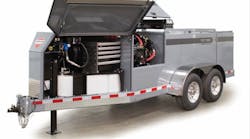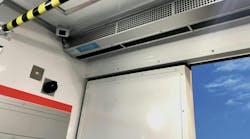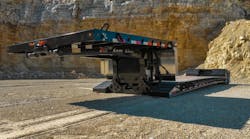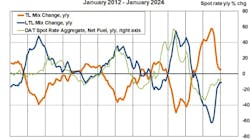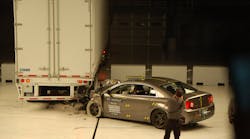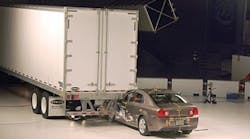The Insurance Institute for Highway Safety is once again testing new underride guards developed by major trailer manufacturers.
Thursday, May 5, it was Stoughton Trailer’s turn. The crash test, conducted at the IIHS research center in Ruckersville, Virginia, involved accelerating a 2010 Chevrolet Malibu to 35 mph and striking the rear of the Stoughton trailer with only 30% of the car’s frontal area. The effect is to place the driver directly in line with the right rear corner of the trailer.
In a 30% offset test, only 30% of the car’s frontal area initially strikes the trailer. Such collisions concentrate the impact on a mere fraction of the guard. Traditional designs, including those shown in the National Highway Traffic Safety Administration’s safety regulations for rear underride, support the horizontal bar of the guard with two horizontal posts. The 30% offset frequently misses the strongest points of the guard, leaving the unsupported ends of the horizontal bar to mitigate the crash. In seven of the eight guards that IIHS tested three years ago, the horizontal bar bent, allowing the car to underride the trailer enough to penetrate the passenger compartment. Manac’s design was the only one to prevent underride during the previous series of tests.
In the latest round of testing, the Institute again is crashing a Chevrolet Malibu into the rear of a trailer at 35 mph. Vanguard’s new underride guard design recently passed its test, and Wabash passed its underride test the last week in April. With these three companies joining Manac, four of the eight largest trailer manufacturers have developed guards that have shown they can prevent underride in all three types of IIHS tests—30% offset, 50% offset, and full-width engagement of the guard.
Stoughton’s design is based on criteria established by IIHS beginning in 2010. The guard includes energy absorption to help decelerate the vehicle impacting it. Stoughton's Gary Fenton said that the guard will be offered without notable increase in tare weight or cost. Stoughton will make the new underride guard standard across the company's product line later this year.
The crash test was part of a special program on underride conducted by IIHS. Look for details in the June issue of Trailer/Body Builders.

